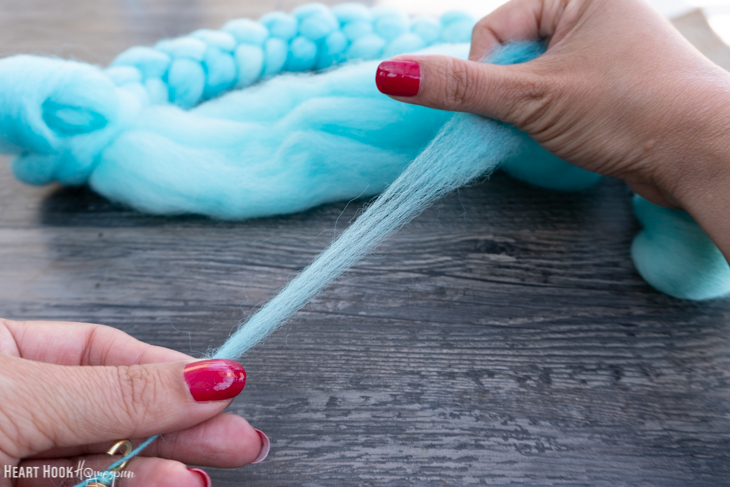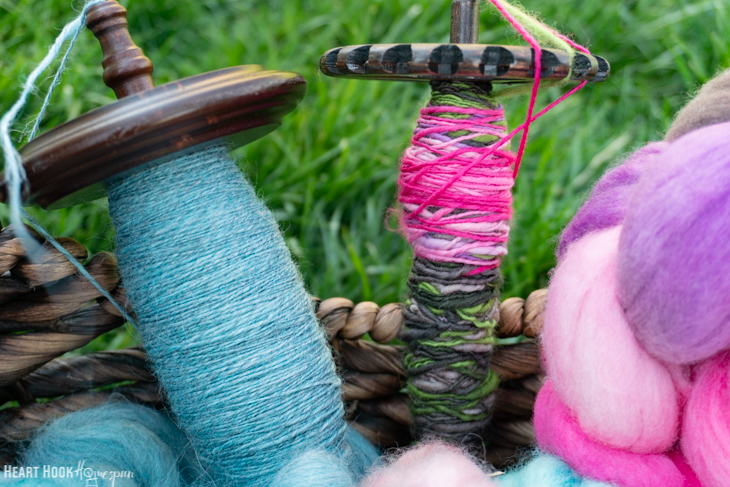There are many benefits of spinning yarn using a drop spindle. In this article we will discuss how to use one, so if you are brand new to drop spinning, this article is for you!

How to Use a Drop Spindle
Drop spinning offers many advantages to that of spinning on a full size spinning wheel. As a beginner, it gives you more control over the process, letting you spin as slowly as needed while learning the intricacies of drafting fiber, building up twist (energy), and ultimately spinning a gorgeous, balanced yarn. Even as an advanced spinner, you may prefer using a drop spindle for various reasons, including portability and ease of use, among others.

For this tutorial today I am using Romney fiber and a top whorl spindle (pictured left) from this Beginner’s Drop Spindle Set I picked up on Etsy.
Benefits of using a drop spindle:
1. More control over drafting.
2. Ability to spin slower than a wheel.
3. Great for beginners while learning the process.
Things to consider on a drop spindle:
1. Leader or no leader?
First, you’ll want to decide whether or not you will use a leader. A leader is a long piece of string or yarn (can be just about anything) attached to the shaft of your spindle so that you can start fresh. If you do not want to start with a leader, that’s okay too! In this example I am starting with a piece of the roving itself, twisted so that it will not break. Here’s how:

Carefully draft out some fiber from the roving.

Twist and twist and twist some more until yarn starts to form.

Hook the yarn you just made and start spinning it back on itself. (Spin the spindle toward you, the spindle should be turning in a clockwise motion if you’re looking down at it.)

You can see that it is ONE strand of yarn, now doubled back on itself and twisted some more.
Now that you have a bit of leader fiber, you’re ready to start spinning!


Twist a bit of the fiber around the shaft, directly below the whorl.

Bring the yarn back up over the whorl, and wrap around the hook TWICE. This keeps it from slipping off as you spin.


Voila! You are now ready to start actually spinning.
Tip! I find it helps consistency if I leave a good 4 – 5″ of yarn above the hook after wrapping, so do not wrap everything you’ve got around the shaft.
2. Park and draft or suspended spinning?
There are two methods of using a drop spindle: park and draft, or suspended spinning.
Generally speaking, beginners find it easier to do the park and draft method, which means that you will spin the spindle (in a clockwise motion, if you’re looking down at it) until you build up enough twist (energy) in the already spun yarn located between the hook and your thumb. When you build up extra twist, “park” the spindle – under your thigh, under your arm, between your feet, etc – and slowly draft out the fibers.


As you get better at spinning and drafting, you’ll be able to move on to suspended spinning. This simply means that as you draft the fibers, the spindle is also spinning. It is reminiscent of patting your head and rubbing your stomach at the same time, so it understandably takes some practice. Which is why beginners find the park and draft method easier!
Here’s how:

See how I have a lot of extra twist built up in this photo? I’ve spun the spindle until I have extra twist in my yarn. (Your thumb’s job here is to stop the twist from traveling into the fiber.) I am now going to carefully draft out fiber from my roving and let that twist (energy) travel up it.


I am positioning my left thumb so that it will now stop the twist from getting past it. Watch how when I release my right thumb it allows that extra twist to travel up, releasing that energy into the drafted fibers, turning it into yarn.

An easy way to test to see if your yarn has enough twist in it, is to fold it back on itself and let it hang. This is called a ply back test, and shows you how kinky (or underspun) your single is. You want it a bit on the kinky side because it will relax a bit in the plying process. If anything, it is better to be a bit too kinky than not enough.
Cool! Once there is no extra built up twist, I am ready to spin the spindle again to build up MORE twist for the next section of fiber. If the yarn between the hook and your thumb is long enough (as in: approaching your arm-span) you will need to unhook it from the spindle, wrap it around the shaft, and bring the yarn back up, hooking around the hook TWICE to keep it from going anywhere while you continue to spin.

You’ll repeat this process until you have used up the entirety of your fiber source. If you need to set it down for a minute, simply wrap the yarn/fiber around the hook/shaft a few more times until you’re ready to pick it back up.
To spin the spindle faster than by hand, I like to start at my right knee, quickly rolling the shaft up my thigh, letting it spin freely until it gets a bit kinky before I park it. Like so:

Then draft out the fibers and let the twist travel up them, using your thumb as the gate. Remember that practice makes perfect, and this is a fun, inexpensive way to learn how to make your own yarn using a drop spindle. Note that you will need to ply your yarn before you use it. This will help to strengthen the yarn and stop it from untwisting.
See: How to ply yarn
Lastly, do not get discouraged if your yarn is less than perfect. Here is a photo of my first attempt. (Hopefully its obvious which it is! lol!)


Share a photo of your own first spin with us in the Heart Hook Homespun Spinners group on Facebook!
You may also like:
DIY Drop Spindle: How to Make a Drop Spindle at Home
What is Staple Length and Why it Matters
Kit says
I am SO impressed, both with your skill in spinning and your ability to succinctly communicate the process. I can’t wait to try!
Anna-Marie Baldwin says
Love all the tutorials, they have been so helpful! I inherited a bottom whorl drop spindle that doesn’t have a hook, do you have tips/resources on how to use that kind. Ive been looking and looking and cant find anything:(
Missy says
Thank you! This was so helpful. Been a few years since I learned in a class and I needed a quick but thorough review, this was perfect!!